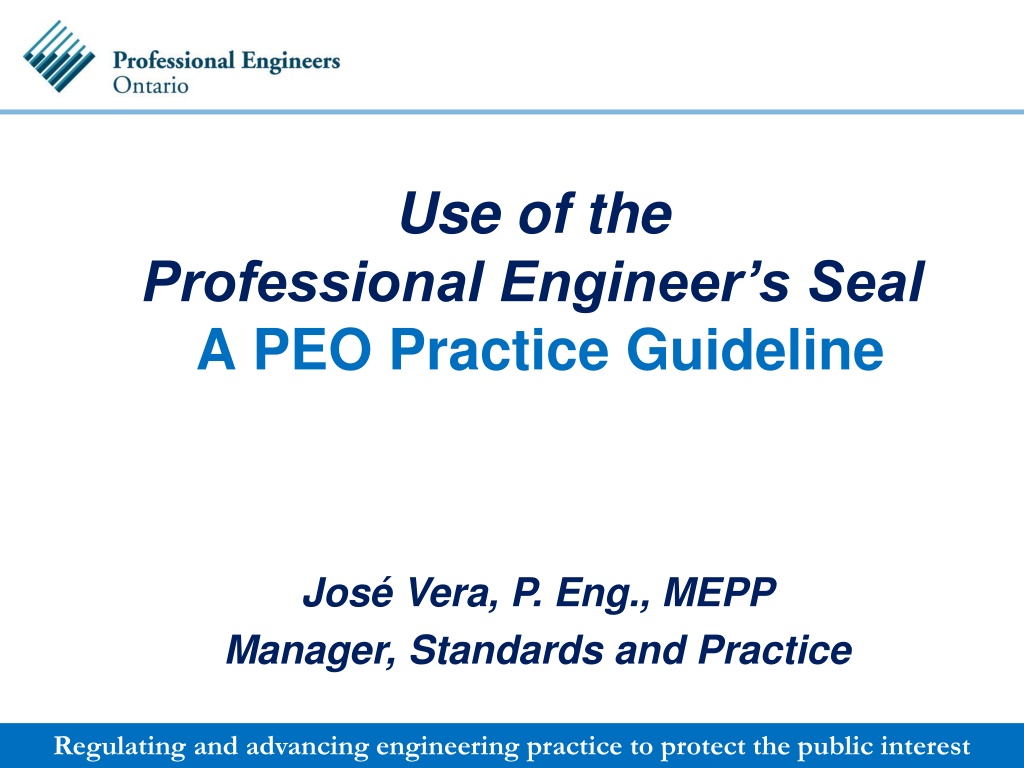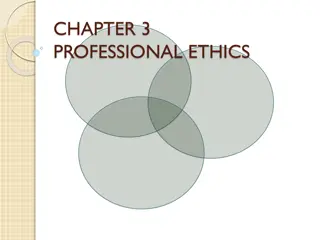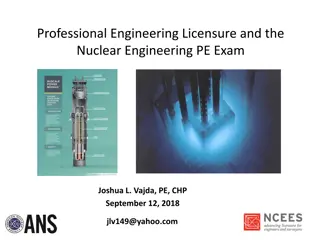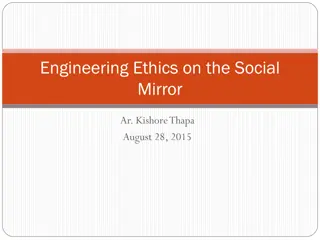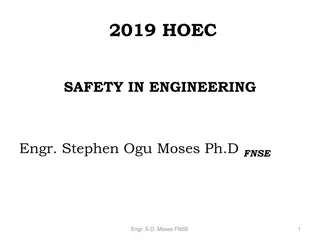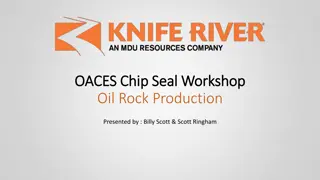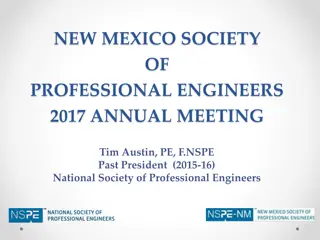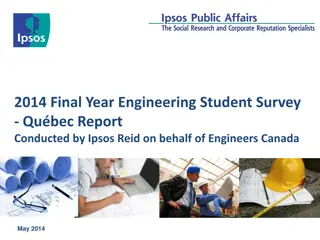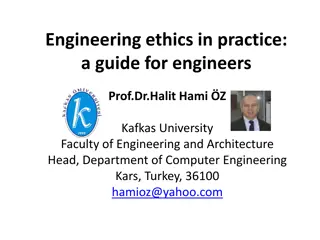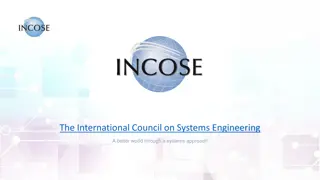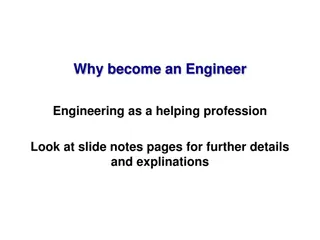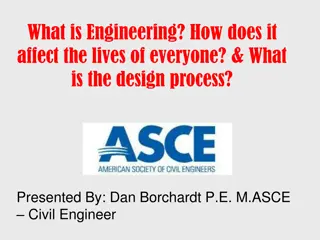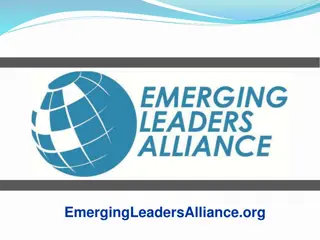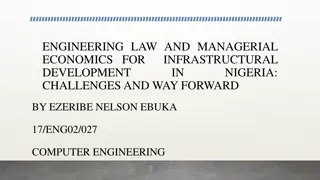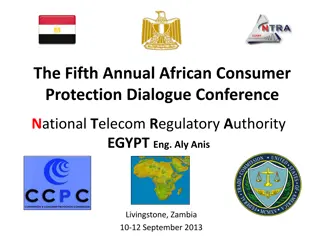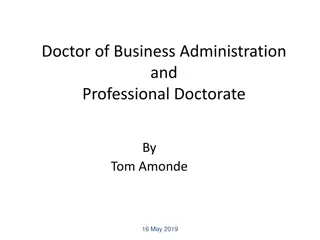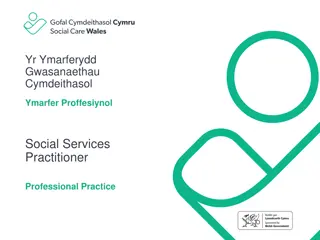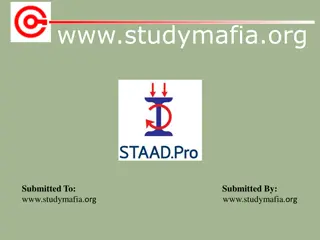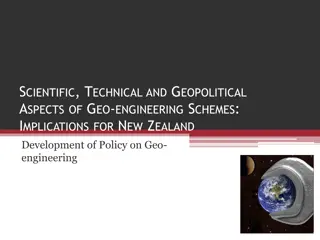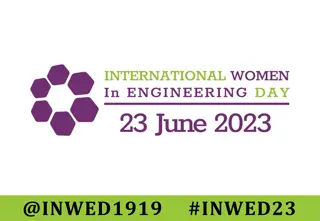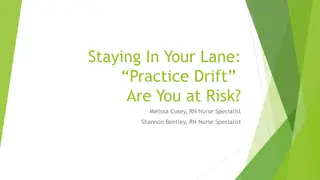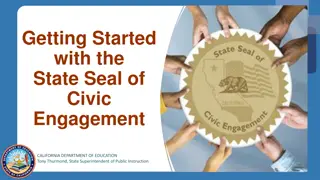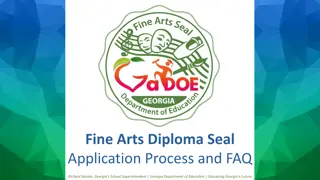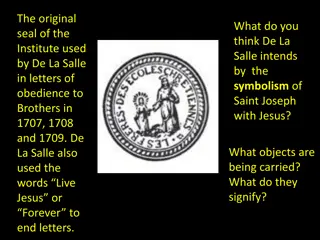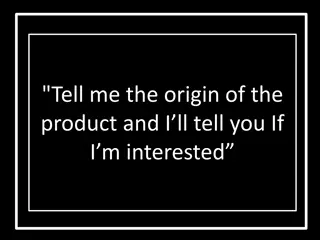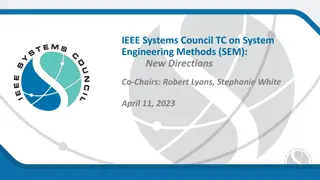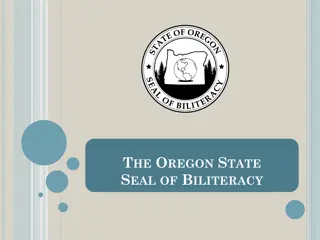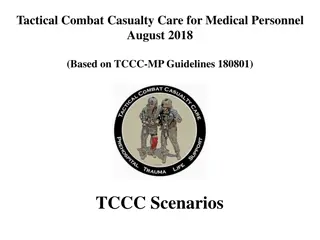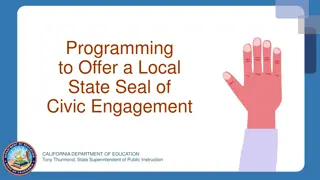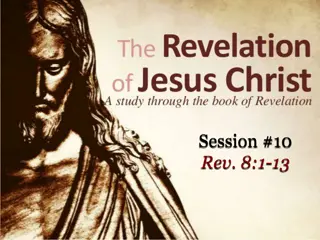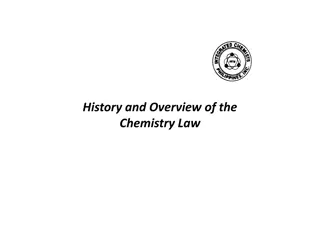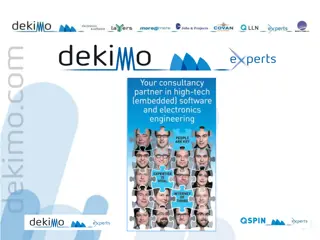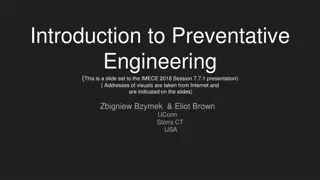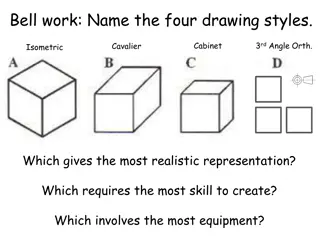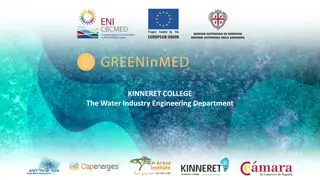Professional Engineer's Seal Guidelines: Regulating and Protecting Engineering Practice
The content delves into the importance and regulations surrounding the use of a Professional Engineer's seal, covering topics such as what should be sealed, who should seal engineering documents, responsibility of engineers, legality of seal usage, and more. It also includes quiz questions to test understanding on the subject.
Download Presentation

Please find below an Image/Link to download the presentation.
The content on the website is provided AS IS for your information and personal use only. It may not be sold, licensed, or shared on other websites without obtaining consent from the author. Download presentation by click this link. If you encounter any issues during the download, it is possible that the publisher has removed the file from their server.
E N D
Presentation Transcript
Use of the Professional Engineer s Seal A PEO Practice Guideline Jos Vera, P. Eng., MEPP Manager, Standards and Practice Regulating and advancing engineering practice to protect the public interest
Agenda Presentation is done in Q & A format and addresses: What should be sealed? What is an engineering document? Who should seal documents? Are engineers responsible for engineering work they prepare? Is there a legal requirement to use the seal? What is the practice of professional engineering? Are electronic seals allowed? 2 Regulating and advancing engineering practice to protect the public interest
Quiz Question #1 Should one seal a passport application? 3 Regulating and advancing engineering practice to protect the public interest
Quiz Question #1 (Answer) Should one seal a passport application? No, but why? 4 Regulating and advancing engineering practice to protect the public interest
Quiz Question #1 (Answer) Should one seal a passport application? No, but why? A passport is not an engineering document. 5 Regulating and advancing engineering practice to protect the public interest
Quiz Question #2 What is an engineering document? Regulating and advancing engineering practice to protect the public interest
Quiz Question #2 (Answer) What is an engineering document? An engineering document is defined in the Use of the Professional Engineer s Seal guideline as follows: An Engineering Document is a document of any kind that expresses engineering work carried out by a professional engineer. In general, it is any output of an engineering design or analysis process, such as design requirements, engineering drawings, specifications, reports, or instructions. Regulating and advancing engineering practice to protect the public interest
Quiz Question #3 Who should seal the engineering work? Regulating and advancing engineering practice to protect the public interest
Quiz Question #3 (Answer) Who should seal the engineering work? The engineer(s) who is taking professional responsibility for the work must seal documents. Regulating and advancing engineering practice to protect the public interest
Quiz Question #4 My friend asked me to notarize a document. Can I use my seal? 10 Regulating and advancing engineering practice to protect the public interest
Quiz Question #4 (Answer) My friend asked me to notarize a document. Can I use my seal? No, but why? 11 Regulating and advancing engineering practice to protect the public interest
Quiz Question #4 (Answer) My friend asked me to notarize a document. Can I use my seal? No, but why? Because an engineer is not a notary. 12 Regulating and advancing engineering practice to protect the public interest
Quiz Question #5 True or False: The seal is considered a certification or warranty. 13 Regulating and advancing engineering practice to protect the public interest
Quiz Question #5 (Answer) True or False: The seal is considered a certification or warranty. False, but why? 14 Regulating and advancing engineering practice to protect the public interest
Quiz Question #5 (Answer) True or False: The seal is considered a certification or warranty. False, but why? The seal attests that a qualified engineer prepared the drawing. It is not a guarantee of accuracy. Edgeworth Construction Ltd. v. N. D. Lea & Associates Ltd. 15 Regulating and advancing engineering practice to protect the public interest
Quiz Question #6 What does the seal communicate to the public? 16 Regulating and advancing engineering practice to protect the public interest
Quiz Question #6 (Answer) What does the seal communicate to the public? It is generally agreed that the stamp and seal of an engineer communicates to the building official and to the public that the contents of the document sealed reflected professional knowledge and care; and that applicable statutes, standards, codes and regulations have been followed. Hilton Canada Inc. v. Magil Construction Ltd. 17 Regulating and advancing engineering practice to protect the public interest
Quiz Question #7 True or False: If I don t seal anything, I am not liable for the work. 18 Regulating and advancing engineering practice to protect the public interest
Quiz Question #7 (Answer) True or False: If I don t seal anything, I am not liable for the work. False, but why? 19 Regulating and advancing engineering practice to protect the public interest
Quiz Question #7 (Answer) True or False: If I don t seal anything, I am not liable for the work. False, but why? A professional engineer is always responsible for their work. 20 Regulating and advancing engineering practice to protect the public interest
Quiz Question #8 True or False: Engineers can revoke the seal in their drawings when clients have not paid for them. 21 Regulating and advancing engineering practice to protect the public interest
Quiz Question #8 (Answer) True or False: Engineers can revoke the seal in their drawings when clients have not paid for them. False, but why? 22 Regulating and advancing engineering practice to protect the public interest
Quiz Question #8 (Answer) True or False: Engineers can revoke the seal in their drawings since when clients have not paid for them. False, but why? Payment is not covered by the Professional Engineers Act. Rather it is a contractual issue. 23 Regulating and advancing engineering practice to protect the public interest
Quiz Question #9 True or False: Sealing documents is a good business practice but not a legal requirement. 24 Regulating and advancing engineering practice to protect the public interest
Quiz Question #9 (Answer) True or False: Sealing documents is a good business practice but not a legal requirement? False, but why? 25 Regulating and advancing engineering practice to protect the public interest
Quiz Question #9 (Answer) True or False: Sealing documents is a good business practice but not a legal requirement. False, but why? Sealing is a requirement under the Professional Engineers Act. 26 Regulating and advancing engineering practice to protect the public interest
Quiz Question #10 When must engineering documents be sealed? 27 Regulating and advancing engineering practice to protect the public interest
Quiz Question #10 (Answer) When must engineering documents be sealed? Section 53 of Regulation 941/90, made under the Professional Engineers Act: - 53. Every holder of a licence, temporary licence, provisional licence or limited licence who provides to the public a service that is within the practice of professional engineering shall sign, date and affix the holder s seal to every final drawing, specification, plan, report or other document prepared or checked by the holder as part of the service before it is issued. R.R.O. 1990, Reg. 941, s. 53; O.Reg. 13/03, s. 16. 28 Regulating and advancing engineering practice to protect the public interest
Quiz Question #11 How can I test if a document needs to be sealed? Regulating and advancing engineering practice to protect the public interest
Quiz Question #11 (Answer) How can I test if a document needs to be sealed? Does the document fall within the practice of professional engineering? Does the document final for the purpose intended? Will the document be issued to others (outside your organization)? 30 Regulating and advancing engineering practice to protect the public interest
Quiz Question #12 True or False: The practice of professional engineering does not have a clear definition but it somehow deals with construction. 31 Regulating and advancing engineering practice to protect the public interest
Quiz Question #12 (Answer) True or False: The practice of professional engineering does not have a clear definition but it somehow deals with construction. False, but why? 32 Regulating and advancing engineering practice to protect the public interest
Quiz Question #12 (Answer) True or False: The practice of professional engineering does not have a clear definition but it somehow deals with construction. False, but why? The practice of professional engineering is defined in the Professional Engineers Act. 33 Regulating and advancing engineering practice to protect the public interest
Practice of Professional Engineering This definition sets out a three-part test for determining whether an act is within the practice of professional engineering: Is an act that involves: designing, evaluating, reporting, etc? Does it involves the public interest? Does it requires the application of engineering principles? 34 Regulating and advancing engineering practice to protect the public interest
Quiz Question #13 Are electronic seals allowed? 35 Regulating and advancing engineering practice to protect the public interest
Quiz Question #13 (Answer) Are electronic seals allowed? Yes, but how? 36 Regulating and advancing engineering practice to protect the public interest
Quiz Question #13 (Answer) Are electronic seals allowed? Yes, but how? An electronic seal is a facsimile of the rubber stamp in electronic format, either scanned or created as a drawing object by a software program. The electronic facsimile must be identical in size, shape, and content to the seal created by the rubber stamp. 37 Regulating and advancing engineering practice to protect the public interest
Quiz Question #14 Our firm uses Notarius to secure electronic documents in Quebec can we use it in Ontario? 38 Regulating and advancing engineering practice to protect the public interest
Quiz Question #14 (answer) Our firm uses Notarius to secure electronic documents in Quebec can we use it in Ontario? Yes 39 Regulating and advancing engineering practice to protect the public interest
Quiz Question #14 (answer) Our firm uses Notarius to secure electronic documents in Quebec can we use it in Ontario? Yes Engineers should use a security method appropriate for the distributed electronic document s risk of alteration or improper use. Notarius can be one such method. 40 Regulating and advancing engineering practice to protect the public interest
Quiz Question #15 A client requested that I seal As-Built drawings prepared by contractor. Can I seal them? 41 Regulating and advancing engineering practice to protect the public interest
Quiz Question #15 (answer) A client requested that I seal As-Built drawings prepared by contractor. Can I seal them? Not unless you verified that the document is accurate 42 Regulating and advancing engineering practice to protect the public interest
Quiz Question #15 (answer) A client requested that I seal As-Built drawings prepared by contractor. Can I seal them? Not unless you verified that the document is accurate Record drawing is document that reflects as- built, as-constructed, as-fabricated conditions that has been verified by an engineer. 43 Regulating and advancing engineering practice to protect the public interest
Quiz Question #16 A client requested that I seal shop drawings prepared by a manufacturer. Can I seal them? 44 Regulating and advancing engineering practice to protect the public interest
Quiz Question #16 (answer) A client requested that I seal shop drawings prepared by a manufacturer. Can I seal them? Not unless you qualify what you are sealing for For example, sometimes an Ontario P. Eng. is asked to review a product designed in US to ensure in meets applicable local standards. 45 Regulating and advancing engineering practice to protect the public interest
Quiz Question #17 Should standard drawings be sealed? 46 Regulating and advancing engineering practice to protect the public interest
Quiz Question #17 (answer) Should standard drawings be sealed? No, but drawings for specific projects that use standard details must be. 47 Regulating and advancing engineering practice to protect the public interest
Quiz Question #18 Only one engineer needs to seal a drawing or a report, right? 48 Regulating and advancing engineering practice to protect the public interest
Quiz Question #18 (answer) Only one engineer needs to seal a drawing or a report, right? Not necessarily, since multi-discipline documents must be sealed by the different engineers taking responsibility for the work in each discipline. Furthermore, any supervising or coordinating engineer must seal their work. 49 Regulating and advancing engineering practice to protect the public interest
Update: Use of the Seal Guideline PEO Council at their November meeting approved forming a subcommittee to review the existing Use of the Professional Engineer's Seal guideline and, in consideration of changes to the industry and professional engineering, revise that document to consider current practices. Regulating and advancing engineering practice to protect the public interest
